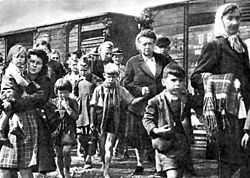Brno death march
 |
| Flight and expulsion of Germans during and after World War II |
|---|
| (demographic estimates) |
| Background |
| Wartime flight and evacuation |
| Post-war flight and expulsion |
| Later emigration |
The Brno march, sometimes also called a death march[1][2][3] (German: Brünner Todesmarsch) began late on the night of 30 May 1945[1] when the ethnic German minority in Brno, capital of the Czechoslovak province Moravia, was expelled to nearby Austria.
The expulsion of the city's 20,000 German inhabitants was directed by the Národní výbor města Brna ("National Committee of the City of Brno"). The psychological motivation was in reaction to the excesses of the war time Nazi occupation.[4] The occupying Wehrmacht garrison occupying Brno had not surrendered the city (analogous to Ostrava and Prague), and the Allies had to seize it by force. Shortly after the war ended, the Czechoslovak government began expelling from the country its large ethnic German minority (over 3 million people, mostly along the German and Austrian borders). Those living in Brno were forced on a march 56 kilometres (35 mi) south towards the Austrian border.[4]
Few of the victims were men, since most male adults had been conscripted into the Wehrmacht and were by then prisoners of war. A greater tragedy than expulsion was to befall the expellees after the Soviet authorities refused to allow them to enter their sector of Austria. (Austria had been divided into four occupation zones, and Moravia bordered the Soviet Occupation Zone.) The Brno Germans were marched back to the city and were interned in the village of Pohořelice. What happened next is controversial. About 700 are confirmed as dying, either by disease (shigellosis) or by murder. Some German sources claim that between 1300–8000 died, but these figures are not supported by the evidence.[4]
The communist agent Bedřich Pokorný, who had organized the 31 July 1945 Ústí massacre of hundreds of ethnic Germans in Ústí nad Labem (German: Aussig an der Elbe), was also behind the Brno event.
There have been attempts to confirm statements that Pokorný had thousands of people executed. Austrian historian Emilia Hrabowecz investigated, but was unable to substantiate it. She did, however, find that old people and tired young children had been sent away on trucks under Czechoslovak guards.[4] In 2002, a joint commission of German and Czech historians collected evidence and published the results in a book titled Rozumět dějinám ("Understanding History").
See also
- List of massacres
- Sudetenland
- Ústí massacre
- Lidice massacre
References
- ↑ 1.0 1.1 Rozumět dějinám, Zdeněk Beneš, p. 208
- ↑ Redrawing Nations: Ethnic Cleansing in East-Central Europe, 1944-1948, by Philipp Ther, Ana Siljak, 2001
- ↑ After the Reich: The Brutal History of Allied Occupation, by Giles MacDonogh, 2007 ISBN 0-465-00337-0
- ↑ 4.0 4.1 4.2 4.3 Rozumět dějinám, Zdeněk Beneš, p. 209
External links
- The Deathmarch of Bruenn – events described from the BRUNA's (organisation of expelled Brno Germans) point of view
- Der Brünner Todesmarsch – das Ende einer Ära (Brno Death March – the End of One Epoch) (German) – larger, more detailed version of the previous article
- Das Deutsche Brünn und sein Ende (German Brno and its End) (German) – another BRUNNA's publication
- „Brněnský pochod smrti“: mýty a skutečnost ("Brno Death March": Myths and Reality) (Czech) – a lecture from international scientific colloquium “Sixty Years since the End of World War II: The End of the Czech-German Coexistence in Czechoslovakia” held in Brno in April 2005